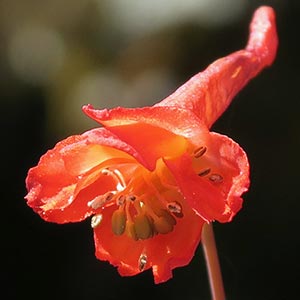Delphinium nudicaule
Delphinium stachydeum
canyon delphinium, canyon larkspur, orange larkspur, red larkspur, red or orange larkspur, scarlet larkspur
hedgenettle larkspur, Rocky Mountain larkspur, spike larkspur, Umatilla larkspur
(15-)20-50(-125) cm;
base reddish, glabrous.
(40-)70-150(-200) cm;
base reddish, puberulent.
blade round to pentagonal, 2-6 × 3-10 cm; ultimate lobes 3-12, width 5-40 mm (basal), 2-20 mm (cauline).
blade light green, ± round, 2-8 × 3.5-11 cm, sparsely pubescent; ultimate lobes 7-19, width 1-8 mm, apex tapering to point;
veins obscure.
5-20(-69)-flowered;
pedicel (1.5-)2-6(-8) cm, glabrous to glandular-pubescent;
bracteoles 14-20(-30) mm from flowers, green to red, linear, 2-4(-9) mm, glabrous to puberulent.
(14-)30-60(-102)-flowered, dense, cylindric;
pedicel spreading, 0.8-2(-3) cm, puberulent;
bracteoles 1-4 mm from flowers, green, linear, 2-7(-10) mm, puberulent.
sepals scarlet to reddish orange, rarely dull yellow, glabrous, lateral sepals forward-pointing to form pseudotube, (6-)8-13(-16) × 3-6 mm, spurs straight, slightly ascending, (12-)18-27(-34) mm;
lower petal blades elevated, exposing stamens, 2-3 mm, clefts 0.5-1 mm;
hairs sparse, evenly dispersed, yellow.
sepals bright blue, puberulent, lateral sepals spreading, 9-13 × 4-7 mm, spurs straight, within 30° above or below horizontal, 11-17 mm;
lower petal blades ± covering stamens, 4-8 mm, clefts 0.5-2 mm;
hairs sparse, centered, mostly near junction of blade and claw above base of cleft, white.
13-26 mm, 3.5-4.5 times longer than wide, glabrous.
10-15 mm, 3.5-4.5 times longer than wide, puberulent.
unwinged or sometimes slightly wing-margined;
seed coat cells with surfaces smooth.
wing-margined;
seed coat cells with margins straight, surfaces ± roughened.
= 16.
Delphinium nudicaule
Delphinium stachydeum
Delphinium nudicaule hybridizes with most other taxa of Delphinium that it encounters. Apparent hybrids involving D. nudicaule, and seen by the author (either afield or as specimens), include D. andersonii, D. antoninum, D. decorum, D. luteum, D. nuttallianum, D. patens, and D. trolliifolium. In addition, garden-grown plants have been hybridized with D. cardinale, D. elatum, D. menziesii, D. parishii, D. penardii, D. tatsienense Franchet, D. triste Fischer ex de Candolle, and D. uliginosum; D. nudicaule does not naturally occur with these species. Delphinium nudicaule is one of the earliest larkspurs to flower in any given locality. Douglas's type collection of D. nudicaule represents plants (synonyms D. sarcophyllum Hooker & Arnott and D. peltatum Hooker, an invalid name) grown under very moist conditions, probably quite near the ocean. The type specimen of D. armeniacum A. Heller represents plants grown under unusually dry conditions.
The Mendocino Indians consider Delphinium nudicaule a narcotic (D. E. Moerman 1986).
(Discussion copyrighted by Flora of North America; reprinted with permission.)
Populations of Delphinium stachydeum are widely scattered in isolated mountain ranges surrounded by desert or grassland. The species has been reported (visual sightings) from northwestern Utah; no specimens have been seen from there. Hybrids between D. stachydeum and D. glaucum have been reported. Although D. stachydeum has been seen flowering within 30 m of flowering D. depauperatum, no hybrids have been observed.
Delphinium stachydeum may possibly be confused with D. geyeri, from which it may be distinguished by its usually greater plant size, less pubescent foliage, and later flowering date. Delphinium stachydeum also may be confused with D. glaucum; see discussion under that species.
(Discussion copyrighted by Flora of North America; reprinted with permission.)
- Local floras:
CA,
OR,
WA
- Local Web sites:
CalFlora,
CalPhotos,
Flora NW,
PNW Herbaria
WildflowerSearch
iNaturalist (observations)
USDA Plants Database
- LBJ Wildflower Center
- SEINet
- Plants of the World Online
- Encyclopedia of Life
- Wikipedia
- Google Image Search


